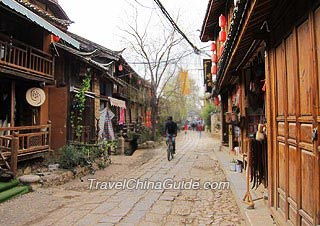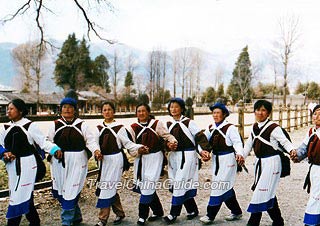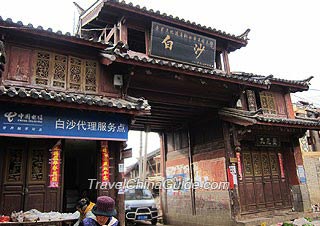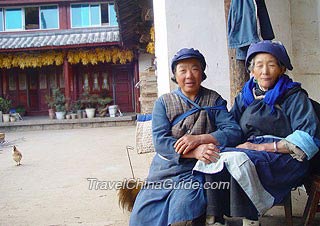Baisha Village
If you want to witness the authentic life of the Naxi People and appreciate their culture, but are tired of overcrowded Lijiang and Shuhe Ancient Town, then Baisha Village is the place to go. The village, at the foot of the Jade Dragon Snow Mountain, is about 8km (4.9 miles) to the north of Lijiang Old Town. It is much quieter because it is not commercialized. Here, you can experience the Naxi people's peaceful daily life.
Baisha Village used to be a Naxi settlement and the birthplace of local Mu Family Governors. It was the political, economic and cultural center of Lijiang prior to the Ming Dynasty (1368 - 1644). Its construction started during the Tang Dynasty (618 - 907) and it became prosperous during the Song (960 - 1279) and Yuan (1271 - 1368) Dynasties. From the Ming Dynasty, the governors moved their families to Dayan Town (the current Lijiang Ancient Town) but still built temples in Baisha Village, making this village a religious center during the early Ming Dynasty. The existing Dabaoji, Liuli and Wenchang Palaces and even the famous Baisha Murals were completed during that period.
Wandering around the Baisha Village, you can enjoy the slow lifestyle of the Naxi People and their friendly smiling faces; see happy and satisfied travelers as well as better scenery than that of Lijiang. You can freely enter various courtyards to see the beautiful and man-made tie-dye artwork hanging for sale or drying in the sun. If you are interested in this artwork, the local small Embroidery School of the Mu Family is worth visiting. There you can admire the local national and traditional embroidery, different from ordinary Chinese embroideries such as the Su Embroidery. A few art stores and hostels, run by local people, are scattered around the Baisha Village.
Heading for this village, the Baisha Murals cannot be missed. These Murals are representative of Lijiang Murals and their creation took about three hundred years, from the early Ming Dynasty to the Qing Dynasty (1644 - 1911). The paintings were finished by Han, Tibetan and Naxi painters as well as painters from other nationalities, so they are not a symbol of Naxi Culture but a fusion of art from different nationalities. The peak of the Lijiang Murals was at end of the Ming Dynasty. Now only 55 pieces of murals are preserved in religious sites around Lijiang Town.
Most of the existing murals are preserved in Dabaoji Palace, a temple built in 1582. Twelve pieces of murals with 167 different figures are painted on the wall with religion as their main theme. The figures of Buddha, the Four Heavenly Kings as well as daily life scenes, plants and animals are included and reflect the combination of several religions and different cultures. The Liuli Palace contains 16 pieces of murals, mainly with figures from Buddhism.
If you are interested in the Buddhist culture, especially Tibetan Buddhism, Fuguo Temple ruins can be included in the itinerary. Baisha Village keeps the Fuguo Temple ruins although the temple is now located in the Black Dragon Pool Park in Lijiang for the convenience of visitors. Being the 'Mother Temple' for Lijiang, the ruins here record not only the history of Lijiang's temples, but also the Tibetan Buddhism and Naxi cultures.
 The local festival is on the twelfth day of the first month of the lunar calendar. On this day, halls on the village's east street will be open for sacrifices to the Gods and different people in Lijiang will gather in Baisha Village. If you are intrigued by the local traditional culture, the festival time is the best time to go.
The local festival is on the twelfth day of the first month of the lunar calendar. On this day, halls on the village's east street will be open for sacrifices to the Gods and different people in Lijiang will gather in Baisha Village. If you are intrigued by the local traditional culture, the festival time is the best time to go.
Several cafes and many Naxi cuisine restaurants can easily be found at Baisha. The Here Restaurant serves western food and its pizzas are well-known.
Local explanations for the murals are rather limited, so you might like to gather information beforehand or hire a local guide if you wish to be fully informed about the murals.
Both local public buses and taxis are available to this village from Lijiang. The taxi fare is around CNY40. Bus line 6 can be boarded at Qixing Street. The bus fare is around CNY2. You can also cycle there.
From Old Town of Shuhe, visitors can use a bicycle or walk to this village. It takes about 30 minutes by bike.
 Top 10 Things to Do in Lijiang
Top 10 Things to Do in Lijiang
History
|
|
Life of Naxi People
Baisha Murals
Dabaoji Palace
Fuguo Temple
 |  |
Tips:
Several cafes and many Naxi cuisine restaurants can easily be found at Baisha. The Here Restaurant serves western food and its pizzas are well-known.
Local explanations for the murals are rather limited, so you might like to gather information beforehand or hire a local guide if you wish to be fully informed about the murals.
How to get to Baisha Village
From Old Town of Shuhe, visitors can use a bicycle or walk to this village. It takes about 30 minutes by bike.
| Entrance Fee | Free * Visitors need to pay CNY 30 if they appreciate the murals in the temple. |
|---|---|
| Opening Hours | The village is available all day around. For murals: 08:00 to 18:00 |
- Last updated on Apr. 12, 2021 -
Questions & Answers on Baisha Village
Asked by Cindy Chimonides | Sep. 01, 2020 07:09 Reply
Reply
Transportation in Yunnan
Is it easy to travel around Yunnan using public transportation or do I need a driver
Answers (1)
Answered by Grace | Sep. 03, 2020 02:14 0
0 0
0 Reply
Reply
Generally speaking, you don't need to worry about the transportation problem because the coach and trains are available. You can easily get to the destination.
Asked by Christina from UNITED KINGDOM | Apr. 19, 2019 07:49 Reply
Reply
Is there a way to travel direct from the Jade Dragon Snow Mountain to Baisha Village?
and vice versa?
Answers (1)
Answered by Jamie from POLAND | Apr. 23, 2019 17:59 0
0 0
0 Reply
Reply
Well, as I know, there is no direct public transportation between these two places. Thus you are suggested to hire a private car.
Asked by E Lee from MALAYSIA | Jun. 27, 2018 00:31 Reply
Reply
What is this protection fee of Lijiang Baisha Village? Who do we pay to?
How much is it now? What if we dont pay?
Answers (1)
Answered by Juno from CANADA | Jun. 27, 2018 22:06 0
0 0
0 Reply
Reply
No, you don’t need to pay any protection fee, it is free. However, if you want to visit Baisha Mural, you have to purchase one ticket for CNY 30.
Asked by Christina from AMERICA | Apr. 18, 2018 15:36 Reply
Reply
is there a bike path to ride from Lijiang to Baisha village?
If no bike path is there a big shoulder next to the road to ride safely?
Answers (1)
Answered by Tiana from AUSTRIA | Apr. 18, 2018 22:06 0
0 0
0 Reply
Reply
Yes, there is and many visitors like to bicycle to the village. You can follow them and have a nice trip!

